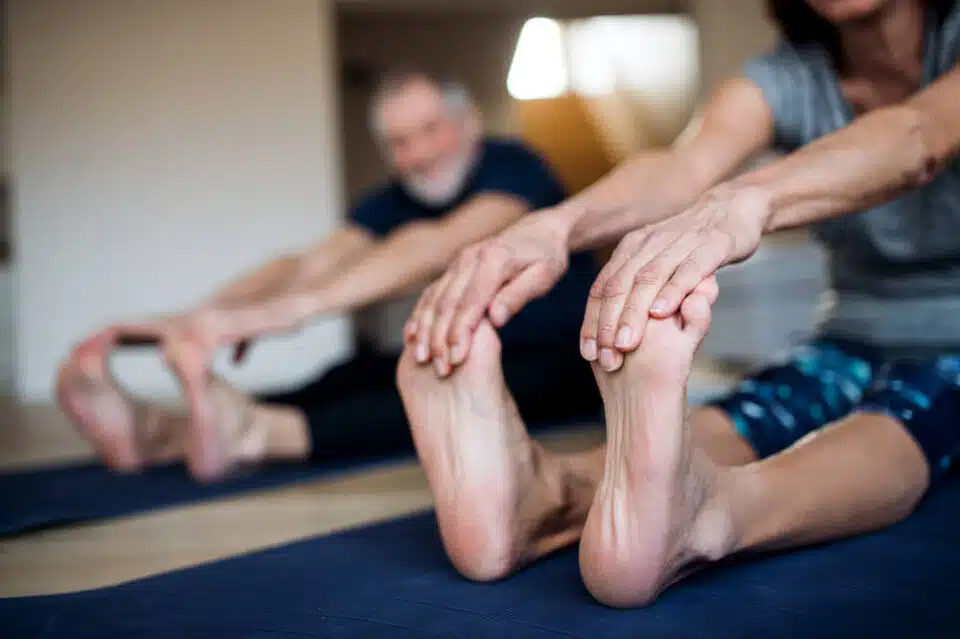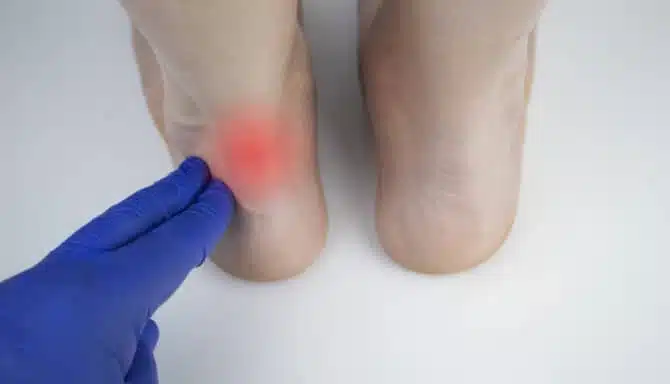As the colder months roll in, it’s important to pay extra attention to your feet. Studies show that foot exercises in the winter can help prevent stiffness and pain by improving blood flow, and keep your feet feeling warm and energized. This is especially important for people with certain foot conditions. By incorporating simple exercises into your routine, you can keep your feet in better shape, even as the temperature drops. Keep reading for five of the best foot exercises to boost circulation and keep your feet healthy throughout the winter.
Today We’ll Learn
- How Foot Exercises Can Improve Blood Circulation in Cold Winter Months
- What foot conditions benefit the most from improved circulation
- The 5 best foot exercises to improve circulation in winter
- How these foot exercises improve blood flow

How Foot Exercises Can Improve Blood Circulation in Cold Winter Months
The circulatory system, also called the cardiovascular system, is responsible for delivering nutrients and oxygen to every part of our bodies. Sufficient blood circulation is very important to the lower extremities, like the feet, ankles and legs, because it helps reduce the risk of muscle cramps and fatigue by removing waste products like carbon dioxide and lactic acid, while also supporting cell repair and overall function.
Poor circulation can lead to swelling, numbness, and cold sensations in your limbs, hands and feet. It can also be connected to serious issues, like diabetes, which can lead to slow-healing wounds, infections, or even ulcers.
Maintaining good blood flow in the legs, ankles, and feet is even more important during the winter because cold temperatures cause blood vessels to constrict, which reduces blood flow to the extremities even more than usual. This can make feet and ankles more prone to stiffness, pain, numbness, and feeling cold.
Maintaining healthy blood flow via foot exercises helps improve mobility, soothes pain, and ensures the feet and lower limbs remain as strong as possible during the cold winter months. They also help people who simply want to keep their feet healthy and stay on top of their winter foot care.
Blood Circulation Exercises for Feet: Conditions Treated
Foot exercises and stretches that boost blood flow can help a wide range of conditions, including:
- Diabetic Neuropathy: Improved circulation might help your body’s circulatory system deliver oxygen and nutrients to nerve tissues. This can help with tingling, numbness and nerve damage.
- Edema (Swelling): Foot exercises stimulate the muscles that help the veins pump blood from your feet back up to your heart. This helps prevent fluid accumulation in the feet and ankles, which in turn reduces swelling in the lower limbs.
- Peripheral Artery Disease (PAD): A common condition that narrows the arteries that restricts blood flow. Foot exercises may alleviate pain and cramping while improving mobility and making walking easier.
- Raynaud’s Phenomenon: A condition in which extremities, like the hands and feet, are particularly sensitive to cold weather, causing the blood vessels to narrow (which then leads to poor circulation and all the other things we mentioned). Stretching and exercising the feet encourages blood flow, which can counteract the effects of Reynaud’s.
- Varicose Veins: These are enlarged, twisted and sometimes painful veins. Exercises that strengthen calf and foot muscles may reduce blood pooling in the veins, while minimizing discomfort and clot risks.
- Plantar fasciitis: An overuse injury that causes inflammation in the plantar fascia and heel pain that comes and goes. Good circulation is essential to help your body heal injuries, so activities that boost circulation may decrease inflammation and speed up the recovery process.
- Arthritis: Increased blood flow delivers oxygen and nutrients to joint tissues, reducing stiffness and improving joint mobility.
1. Foot Massage with Tennis Ball
How to do it:
- While standing, place one foot on the tennis ball and press down gently. Roll the bottle back and forth under your foot, starting from the heel and moving to the toes. Use your body weight to adjust the pressure, ensuring it’s comfortable but effective.
- Roll each foot for about 1–2 minutes. Focus on different areas, such as the arch and ball of the foot, to help relieve tension and boost circulation.
- You can also use a lacrosse or golf ball, or a therapeutic massage ball.
2. Toe Splays
How to do it:
- While seated, plant your feet flat on the ground.
- Bunch your toes together by scrunching them inward, keeping the movement controlled.
- Press your big toe firmly into the ground while spreading the other toes as far apart as possible, holding before relaxing.
- Perform on both feet at the same time, or one foot at a time.
3. Toe Flex and Raises
How to do it:
- Start in a seated position with your feet flat on the floor.
- Flex your toes upward towards the sky before flexing them downwards towards the floor.
- Repeat 10-15 times on each foot.
4. Pen Pick-Ups
How to do it:
- Stay seated.
- Lay three pens, or similarly shaped objects, in front of you–spaced apart evenly.
- Using your toes, pick up each pen and place it in a bowl.
5. Seated Toe Pulls
How to do it:
- While sitting on a chair and cross one foot over the opposite knee.
- Pull your toes toward you and hold them in that position for 30-50 seconds.
- Repeat 2-3 times on each foot.
How These Foot Exercises Improve Blood Flow
Exercises like the tennis ball massage boost blood flow by stimulating the muscles on the bottom of the foot. In more scientific terms, they target the plantar aspect (sole of the foot), which stabilizes the arch. It also releases tension in the plantar fascia, improving its elasticity and promoting better circulation in the surrounding tissues. This enhanced blood flow helps deliver oxygen and essential nutrients to the area, aiding in healing and reducing inflammation. Additionally, as the blood vessels dilate, the foot’s tissues become more flexible and less prone to tension.
Toe splays, toe flexes and raises, and similar exercises activate the intrinsic muscles of the foot. These muscles are located within the foot itself, as opposed to the extrinsic muscles that originate in the lower leg and insert into the foot.
These intrinsic muscles help control fine movements of the toes, stabilize the arch, and support balance. When they’re activated during toe exercises, they stimulate the foot’s blood vessels and promote better circulation. More specifically, working the toes can enhance venous return, which is the process by which blood is pumped back to the heart. The activation of these foot muscles also helps compress the veins, aiding in the movement of blood against gravity.
By targeting the small, intrinsic muscles, these exercises help to balance the workload between the foot’s various structures, preventing overuse injuries in the larger, more externally located muscles. Strengthening these muscles can also improve overall posture and movement patterns, reducing the risk of misalignments or discomfort that may radiate through the legs and lower back. When the foot muscles are conditioned and have good range of motion, they allow for better shock absorption and energy transfer during activities like walking, running, and standing. This reduces strain on other parts of the body, contributing to overall musculoskeletal health.
Furthermore, foot exercises like toe flexes, raises, and splays support better sensory feedback from the ground, enhancing proprioception—the body’s ability to sense its position and movement. Improved proprioception helps with balance and stability, particularly in individuals who may be recovering from an injury or who experience frequent falls due to weakened muscles or poor circulation. By exercising the foot muscles, the brain receives clearer signals from the feet, which can enhance coordination and response times during daily movement. This can be particularly helpful for older adults or individuals with conditions that affect motor skills.















